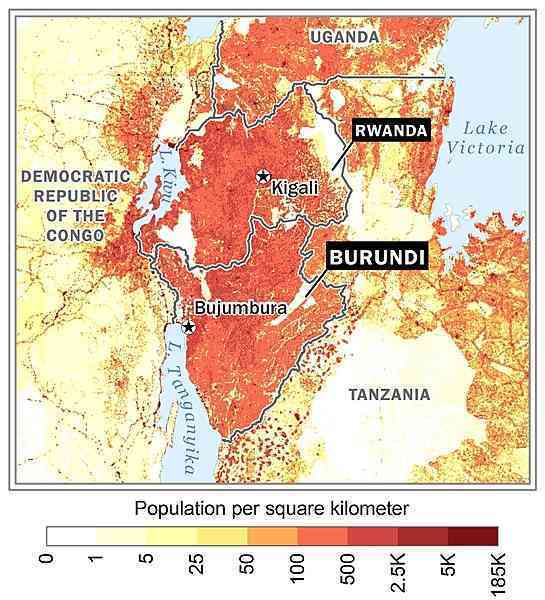
Central Africa, east of the Democratic Republic of the Congo, west of Tanzania
3 30 S, 30 00 E
Africa
total: 27,830 sq km
land: 25,680 sq km
water: 2,150 sq km
slightly smaller than Maryland
total: 1,140 km
border countries (3): Democratic Republic of the Congo 236 km; Rwanda 315 km; Tanzania 589 km
0 km (landlocked)
none (landlocked)
equatorial; high plateau with considerable altitude variation (772 m to 2,670 m above sea level); average annual temperature varies with altitude from 23 to 17 degrees Celsius but is generally moderate as the average altitude is about 1,700 m; average annual rainfall is about 150 cm; two wet seasons (February to May and September to November), and two dry seasons (June to August and December to January)
hilly and mountainous, dropping to a plateau in east, some plains
highest point: unnamed elevation on Mukike Range 2,685 m
lowest point: Lake Tanganyika 772 m
mean elevation: 1,504 m
nickel, uranium, rare earth oxides, peat, cobalt, copper, platinum, vanadium, arable land, hydropower, niobium, tantalum, gold, tin, tungsten, kaolin, limestone
agricultural land: 73.3% (2018 est.)
arable land: 38.9% (2018 est.)
permanent crops: 15.6% (2018 est.)
permanent pasture: 18.8% (2018 est.)
forest: 6.6% (2018 est.)
other: 20.1% (2018 est.)
230 sq km (2012)
fresh water lake(s): Lake Tanganyika (shared with Democratic Republic of Congo, Tanzania, and Zambia) - 32,000 sq km
Atlantic Ocean drainage: Congo (3,730,881 sq km), (Mediterranean Sea) Nile (3,254,853 sq km)
one of Africa's most densely populated countries; concentrations tend to be in the north and along the northern shore of Lake Tanganyika in the west; most people live on farms near areas of fertile volcanic soil as shown in this 
flooding; landslides; drought
landlocked; straddles crest of the Nile-Congo watershed; the Kagera, which drains into Lake Victoria, is the most remote headstream of the White Nile
NOTE: The information regarding Burundi on this page is re-published from the 2024 World Fact Book of the United States Central Intelligence Agency and other sources. No claims are made regarding the accuracy of Burundi 2024 information contained here. All suggestions for corrections of any errors about Burundi 2024 should be addressed to the CIA or the source cited on each page.
This page was last modified 04 May 24, Copyright © 2024 ITA all rights reserved.